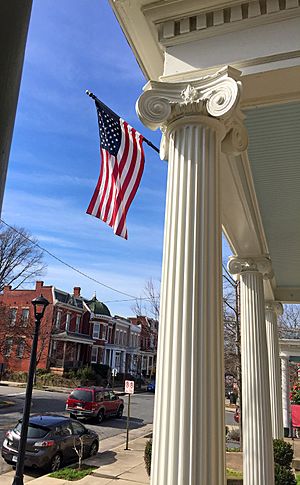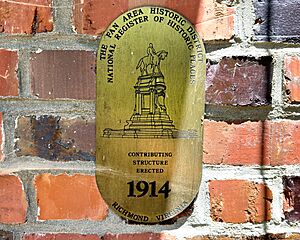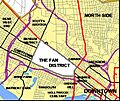Fan District facts for kids
|
Fan Area Historic District
|
|

A street in the Fan
|
|
| Location | Roughly bounded by N. Harrison, W. Main, W. Grace and N. Mullberry Sts., Richmond, Virginia |
|---|---|
| Area | 228 acres (92 ha) |
| Architect | Multiple |
| Architectural style | Mid 19th Century Revival, Late 19th-20th Century Revivals, Late Victorian |
| NRHP reference No. | 85002243 |
Quick facts for kids Significant dates |
|
| Added to NRHP | September 12, 1985 |
The Fan is a well-known neighborhood in Richmond, Virginia. It gets its name because its streets spread out like a fan. This area stretches west from Belvidere Street, near Monroe Park, to Arthur Ashe Boulevard.
The Fan is a lively place with many homes, parks, and tree-lined streets. It's also where you'll find part of Virginia Commonwealth University (VCU). The neighborhood has lots of local cafes and restaurants. It's also home to Monument Avenue, a famous street that once had statues of important figures. Today, you can see a modern statue of tennis legend Arthur Ashe there.
Contents
Exploring The Fan District
The Fan District is mostly a residential area. This means it has many homes built in the late 1800s and early 1900s. Besides homes, you'll find VCU's Monroe Park Campus. There are also several parks and many places of worship.
The Fan is close to other interesting Richmond neighborhoods. These include the Boulevard, the Museum District, and Carytown. Carytown is known for the beautiful Byrd Theatre.
Some of the main streets that run east to west through the Fan include Broad Street, Grace Street, and Monument Avenue. You can also find Patterson Avenue, Grove Avenue, Floyd Avenue, Main Street, and Cary Street.
The Fan's Unique Buildings
The Fan is famous for its many buildings that show off different styles. Many homes here were built during the Victorian and Edwardian eras. These styles were popular in the late 1800s and early 1900s.
One special building is the Branch House on Monument Avenue. It was designed in 1914. Since 2005, it has been home to the Virginia Center for Architecture, which is a museum about building design.
While many buildings look Victorian, some were built a bit later. These often have a simpler, more classic look. You'll also see homes in the Colonial Revival style. This style brings back ideas from early American architecture.
Some of the main building styles you can see in The Fan include:
- Italianate
- Richardsonian Romanesque
- Queen Anne
- Colonial Revival
Other styles found here are:
- Tudor Revival
- Second Empire
- Beaux-Arts
- Art Deco
- Spanish
- Gothic Revival
- Bungalow
- American Arts and Crafts Movement
A Look at The Fan's History
The land where The Fan now stands was first planned as a village called Sydney in 1817. Most of The Fan was built after the American Civil War and up until about 1920.
Electric streetcars played a big role in how The Fan grew. Richmond had the first electric streetcar system in the country, starting in 1888. These streetcar lines made it easy to travel from downtown. This encouraged people to build homes further west.
By the early 1900s, Franklin Street in The Fan became a very fashionable address. This led to a quick building boom. The area changed from tobacco fields in 1880 to a fully developed neighborhood by the 1920s.
During the Great Depression, many of the large single-family homes were changed into apartments. This helped more people find places to live.
The name "The Fan" became popular in the mid-1900s. It was first used by a local newspaper. In 1985, The Fan was added to the National Register of Historic Places. You can often see plaques on buildings in The Fan that show when they were built and that they are part of this historic list.
Maps of The Fan
-
The Fan is one of many Neighborhoods of Richmond Virginia.









